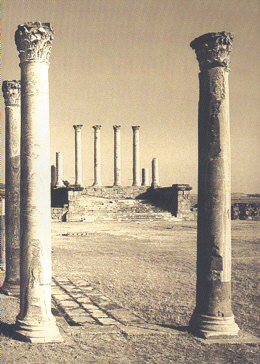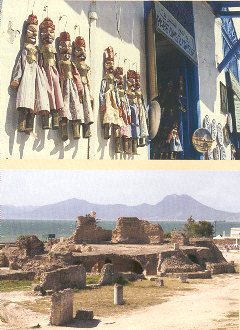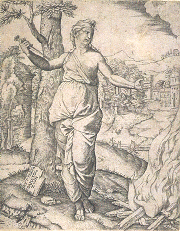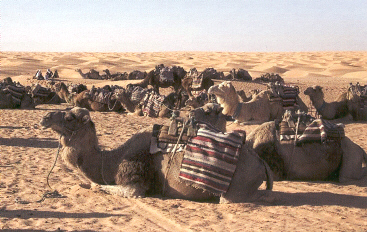|
It is related in the legends that when the
ancient Phoenician mariners first sailed into the Bay of
Carthage (Gulf of Tunis) they saw on the horizon the
pine clad pinnacle of “Bu Kornain” – the most
conspicuous landmark on the Tunisian coastline. The
head of the summit was curved on the mount forming the
shape of two horns – a symbol of their deity Baal – and
taking this as a happy omen they decided to settle down
on the coastline under the rule of Elissar, Queen of
Carthage.
Tunisia was a kingdom within the French Union from 1881
until 1956, when it was granted independence and
conceded power to the nationalist leader Habib Bourguiba.
Modern Tunisia is situated at a key point in the Western
Mediterranean stretching outwards to Sicily and derives
its sense of nationhood from an awareness of its great
past; its unique culture and traditions dominated by
Islam for the past fourteen centuries and from a common
language - Arabic, which makes it a part of the Arab
world that stretches from the shores of Atlantic Ocean
in the West to the Arabian Gulf in the East.
You can sense the wonder of old Tunisia everywhere and feel
that its history, its monuments and its culture combine
to make a very special modern nation. The site of
ancient Carthage has been inherited by that modern
nation but today it stands sadly shorn of the greatness
that once made it the most important and prosperous city
in the Phoenician Empire.
Ancient History
In 814 BCE the city of
Carthage was founded in present-day
Tunisia by Queen Elissar, a former princess
of Tyre. Her brother, King Pygmalion of Tyre, murdered
her husband the high priest. Elissar escaped the
tyranny of her own country and founded Carthage and
subsequently its later dominions. At its peak her
metropolis came to be called a "shining city," ruling
300 other cities around the western Mediterranean and
leading the Phoenician Punic world.

It was at Carthage where Elissar first met Aeneas, the great
Greek hero, who had fled the burning city of Troy and
was shipwrecked and stranded on the shores of Carthage.
Queen Elissar (known also as Dido from a Phoenician word
meaning ‘wanderer’) found him irresistible as a man with
his regal bearing and manners and she fell passionately
in love with him. In Virgil's
Aeneid,
Dido is first introduced as an extremely well respected
character. In just seven years, since their exodus from
Tyre,
the Carthaginians had built a successful kingdom under
her rule. Her subjects adored her and presented her
with a festival of praise. Her character is perceived
as even more noble when she offers asylum to
Aeneas
and his men, who have recently escaped from
Troy.
However, when Aeneas is reminded by Jupiter’s messenger,
Mercury, that his mission is not to stay in Carthage
with his new-found love, Dido, but to travel to Italy to
found Rome, Dido’s character takes a turn for the
worse. When Aeneas deserts her, she becomes vengeful
and orders a pyre to be built so that she may burn the
possessions he left behind. It is on this pyre that
Dido has a vision of the future Carthaginian general,
Hannibal, avenging her. With her final
breath she stabs herself.
From 700 to 409 BCE there were repeated conflicts between
Carthage and
Greece
over spheres of influence and trade routes. Under the
Magonid dynasty, the Carthaginians dominated the Western
Mediterranean but the Greeks regained the upper hand at
the Battle of Imera in 480 BCE. Skirmishes between
Greeks and Carthaginians in
Sicily
spilled over to mainland Tunisia in 311 BCE when the
Greeks invaded Cap Bon. Carthage became a major rival
to the
Roman
Republic for the domination of the Western
Mediterranean in the
4th
century BCE, leading to the
First
Punic War. From 218 to 202 BCE the
Second
Punic War ravaged the region, with
Hannibal crossing the
Alps
to attack
Rome.
Carthage was eventually destroyed – razed to the ground
by vengeful Romans -during the
Third
Punic War, and Tunisia was made part of the
Roman
Empire and its citizens sold into slavery.
The Carthaginian general Hannibal (247-182 BCE), perhaps the
best know son of Carthage, was one of the greatest
military leaders in history. His most famous campaign
took place during the Second Punic War (218-202 BCE),
when he caught the Romans off-guard by crossing the
Alps.
When Hannibal was born in 247 BCE, his birthplace,
Carthage, was a humiliated city: it had been the
Mediterranean's most prosperous seaport and had
possessed wealthy provinces but it had recently been
defeated by the Romans, who had stripped Carthage of
most of its overseas territories - Sicily, Sardinia and
Corsica.
Hannibal was the oldest son of the Carthaginian general
Hamilcar Barca, who took him to Spain in 237BCE, where
he was trying to conquer Andalusia, compensating for the
loss of the Carthaginian provinces to Rome. When
Hamilcar died in 229 BCE, Hannibal's brother-in-law
Hasdrubal took over command. The new governor secured
the Carthaginian position by diplomatic means, among
which was intermarriage between Carthaginians and
Iberians. Hannibal married a native princess.
In 221 BCE, Hasdrubal was murdered and Hannibal was elected
commander by the Carthaginian army in Spain. He
returned to his father's military politics and attacked
the natives again: in 220 BCE he took Salamanca. The
next year, he besieged Saguntum, a Roman ally. Since
Rome’s attention was occupied with the Second Illyrian
War and was consequently unable to support the town,
Saguntum fell after a blockade of eight months.
In 219 BCE in his most daringly brilliant military manoeuvre,
Hannibal launched an attack on the city of Rome itself
by marching with his army, made up of elephants, horses
and soldiers, across the Alps and inflicting crushing
defeat on the Roman armies who stood in his way. He
managed to engage the Roman army for sixteen years on
hostile territory before they got the upper. He
committed suicide by poisoning himself in 182 BCE,
embracing death and denying the attempts of Romans to
make him their prisoner. His famous last words were
'Let us put an end to the anxiety of the Romans who have
grown weary of waiting for the death of a hated old
man'.
After defeating the Carthaginians the Romans, in 146 BCE,
made their capital in Utica, further along the coast.
Middle Ages
An
Arab
Muslim
army entered Tunisia in
670
CE under the command of
Uqba
ibn Nafa with the intention of staying
permanently. Arriving by land the Arabs passed the
Byzantine strongholds along the coast. They
founded the city of
Kairouan, using it as a base from which to
subdue individual pockets of Christian and
Berber
resistance. Tunisia was considered a natural centre for
an Arab-Islamic regime and society in North Africa. It
was the only region that had the urban, agricultural,
and commercial infrastructures essential for a
centralized state.
After several generations a local Arab aristocracy
emerged, which was resentful of the distant Caliphate's
interference in local matters. A minor rebellion in
Tunis
in
797
CE took on a more ominous nature when it spread to
Kairouan. The Caliph's governor was unable to restore
order, but
Ibrahim ibn al-Aghlab, a provincial leader,
had a well-disciplined army and could. He proposed to
the Caliph,
Harun
al-Rashid, that he be granted
Ifriqiya as a hereditary fief and he agreed.
Ibrahim bin al-Aghlab and his decendants, known as the
Aghlabids, ruled Tunisia, Tripolitania, and
eastern Algeria on behalf of the Caliph from 800 to 909
CE. The Aghlabid military elites were drawn from the
descendants of Arab invaders, Islamised and Arabised
Berbers and black slave soldiers. The
administrative staffs comprised dependent client Arab
and
Persian immigrants, bi-lingual natives, and
some Christians and
Jews.
Tunisia flourished under Aghlabid rule. Extensive
irrigation works were installed to supply towns with
water, irrigate royal gardens, and promote olive
production. In the
Kairouan region hundreds of basins were
constructed to store water to support horse raising.
Important trade routes linked Tunisia with the Sahara,
the Sudan, and the Mediterranean And in 835 CE the
Aghlabid armies captured
Sicily.
Later on, anarchy made Tunisia a target for the
Norman kingdom that had been established in Sicily, who
between 1134 and 1148 seized
Mahdia,
Gabes,
Sfax,
and the island of
Djerba.
The only credible Muslim rulers in the Maghreb at the
time were the
Almohads (ruled 1130 - 1269) in Morocco, who
responded with a counter-attack which forced the Normans
to retreat to Sicily. The Almohad Caliph
Abd
al-Mu'min (1130 - 1163) conquered Morocco,
intervened in Spain, and invaded Algeria and Tunisia.
The Almohad empire, like its predecessors, soon
dissolved in Tunisia. In 1230 they were succeeded by
the
Hafsids who ruled between 1230 and 1574 and
who were recognised by Mecca, which furthermore
acknowledged the ruler
Al-Mustansir
as Caliph. In
1270
an attempted invasion by
Louis
IX of France was repulsed. Tunisia prospered
through increasing European and Sudanese trade under Al-Mustansir,
who used the money to transform Tunis, his capital, with
a palace and the Abu Fihr park. The estate he created
near
Bizerte was said to be without equal in the
world.
In 1492 Muslim and Jewish immigration from Spain, as a
result of their expulsion, culminated in the fall of
Muslim
Granada. The newcomers brought much-needed
skills in agriculture and crafts. From 1534 to 1581
Tunisia become a pawn in power struggles between Spain
and Turkey and in
1574
it was finally incorporated into the
Ottoman Empire.
Ottoman Empire in Tunisia

The Tunisian state was rebuilt
with the imposition of
Ottoman rule in the late 16th century. In
1574,the Ottomans made Tunisia a province of their
empire and garrisoned Tunis with 4,000
Janissaries recruited from Anatolia,
reinforced by Christian converts to Islam from Italy,
Spain, and Provence. In
1591
the local Janissary officers replaced the Sultan's
appointee with one of their own men, called the
Dey.
While the Dey dominated Tunis, a Corsican-born Tunisian
tax collector (Bey)
named Murad (d.
1640),
and his descendants, dominated the rest of the country.
The struggle for power made allies of the Dey, the
Janissaries, and Bedouin tribes against the Beys, the
towns, and the fertile region of the countryside. The
Muradid Beys eventually triumphed, and ruled until 1705,
when
Hussein ibn Ali came to power. The period
from 1705 to 1957 witnessed the reign of the Husseinite
Beys, including the highly effective
Hammouda Pasha (1781 - 1813). In theory,
Tunisia continued to be a vassal of the Ottoman Empire -
the Friday prayer was pronounced in the name of the
Ottoman Sultan, money was coined in his honour and an
annual ambassador brought gifts to Istanbul - but the
Ottomans never again exacted obeisance.
Modern history
In the
19th
century, the country became mostly
autonomous, although officially still an Ottoman
province. In
1861,
Tunisia enacted the first constitution in the Arab
world, but a move toward a
republic was hampered by the poor economy and
political unrest. In
1869,
Tunisia declared itself bankrupt and an international
financial commission with representatives from
France,
United
Kingdom, and
Italy
took control over the economy.
In the spring of
1881,
France invaded Tunisia, claiming that Tunisian troops
had crossed the border to
Algeria, France's main
colony
in
Northern Africa. Italy, also interested in
Tunisia, protested, but did not risk a war with France.
On
May 12
of that year, Tunisia was officially made a French
protectorate. The French progressively
assumed the most responsible administrative positions,
and by 1884 they supervised all Tunisian government
bureaus dealing with finance, post, education,
telegraph, public works and agriculture. They abolished
the international finance commission and guaranteed the
Tunisian debt, establishing a new judicial system for
Europeans while keeping the sharia courts available for
cases involving Tunisians, and developed roads, ports,
railroads, and mines. In rural areas they strengthened
the local officials (qa'ids) and weakened independent
tribes. They actively encouraged French settlements in
the country: the number of French colonists grew from
34,000 in 1906 to 144,000 in 1945, and the French
occupied approximately one-fifth of the cultivable
land.
Nationalist sentiment increased after
World
War I. The nationalist
Destour Party was set up in 1920. Its
successor the
Neo-Destour
Party, established in 1934 and led by
Habib
Bourguiba, was banned by the French.


During
World
War II, the French authorities in Tunisia
supported the
Vichy
government which ruled France after its capitulation to
Germany in
1940.
After losing a string of battles to General Montgomery
in
1942
and then hearing of the landings during
Operation Torch,
Erwin
Rommel retreated to Tunisia to set up strong
defensive positions in the mountains to the South.
Overwhelming British superiority eventually broke these
lines, although he did have some success against the
green
American troops advancing from the West. The
fighting ended in early
1943
and Tunisia became a base of operations for the invasion
of
Sicily
later that year. It was very important in
World
War II. Violent resistance to French rule
boiled up in
1954.
Tunisia since independence
Independence from
France
was achieved on
March
20,
1956,
as a
constitutional monarchy with the
Bey of
Tunis,
Muhammad VIII al-Amin Bey, as the king of
Tunisia. Prime Minister
Habib
Bourguiba abolished the monarchy in
1957
and established a strict state under the Neo-Destour
(New Constitution) party. He dominated the country for
31 years, supressing
Islamic
fundamentalism and establishing rights for
women unmatched by any other Arab nation. Bourguiba
envisioned a Tunisian republic (he ended the old
quasi-monarchical institution of the Dey), which was
secular, populist, and imbued with a kind of French
rationalist vision of the state that was Napoleonic in
spirit. Socialism was not initially part of the
project, but re-distibutive policies certainly were. In
1964, however, Tunisia entered a short lived socialist
era. The Neo-Destour party became the Socialist Destour,
and the new minister of planning, Ahmed Ben Salah,
formulated a state-led plan for the formation of
agricultural cooperatives and public-sector
industrialisation. The socialist experiment raised
considerable opposition within Bourguiba's old coalition
and it was eventually ended in the early 1970s.
"Bourguibism" was also resolutely non-military, arguing that
Tunisia could never be a credible military power and
that the building of a large military establishment
would only consume scarce investment and perhaps thrust
Tunisia into the cycles of military intervention in
politics that had plagued the rest of the Middle East.
President Bourguiba was overthrown and replaced by Prime
Minister
Zine
El Abidine Ben Ali on
November 7,
1987.
President Ben Ali changed little in the Bourguibist
system except to rename the party the Democratic
Constitutional Rally (RCD by its French acronym). In
1988 Ben Ali tried a new tack with reference to the
government and Islam, attempting to reaffirm the
country's Islamic identity by releasing several
Islamists activists from prison. He also forged a
national pact with the Tunisian party Harakat al-Ittijah
al-Islami (Islamic Tendency Movement, founded in 1981),
which changed its name to an-Nahda (the Renaissance
Party). An-Nahda ran strongly in the 1989 elections,
and Ben Ali quickly banned Islamist political parties
and jailed as many as 8,000 activists. In recent years,
Tunisia has taken a moderate, non-aligned stance in its
foreign relations.
Today Tunisia is a country of contrasts: modern &
ancient; Carthage, Rome and Vandals; Arab, Berber and
above all Muslim. It has ancient ruins, archaeological
sites and is a modern Mediterranean North African
country. But above all it has History in
abundance. Go and visit – the payback is enormous. |
